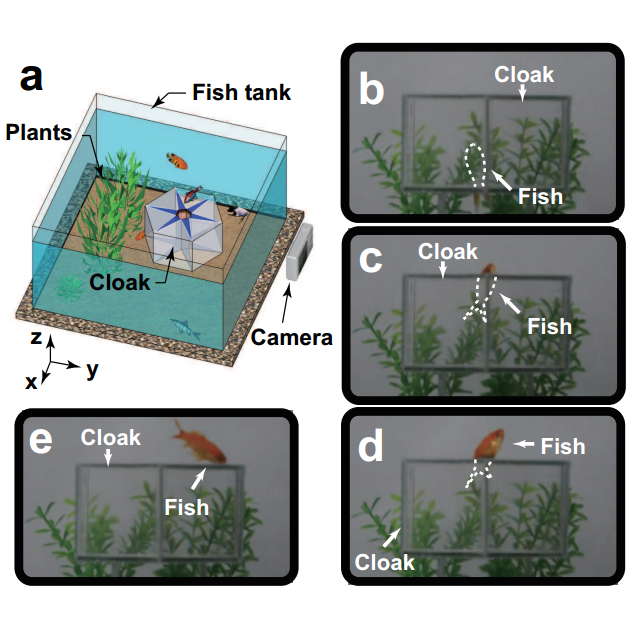More Large-Scale Invisibility Cloaks, This Time From China and Beyond
Last week, we looked at an invisibility cloak large enough to hide a human and that works across all optical frequencies. This cloak was simple in design, cheap to build and, perhaps most important of all, scalable to almost any size.

It had one serious drawback, however. This cloak only worked when viewed from one direction. Look at this device from any other angle and its cloaking effect is lost.
Today, Hongsheng Chen at Zhejiang University in China and an international circle of friends, reveal a different take on the same design. These guys have created large-scale invisibility cloaks that work over the entire optical spectrum but can cloak in several directions at once.
Invisibility cloaks work by steering light around a cavity to make it look as though it wasn’t there. This is a difficult job to do perfectly since any light rays that are steered around an object must travel faster than neighbouring rays that do not change direction. That requires various superluminal tricks that are difficult to master.
But Hongsheng and co point out that this need to keep up with the neighbours is only necessary when the objects are viewed with coherent light in which the waves are in phase. That’s not the case for human vision in the optical spectrum, which is broadband and incoherent. Humans, and indeed most other creatures, are not sensitive to the phase of light or changes in polarisation.
Hongsheng and co point out that relaxing this requirement suddenly makes invisibility cloaks much easier to design and build on a large scale. “Therefore, abandoning the requirement of phase preservation for natural light cloaking opens the door to hide large-scale living creatures,” they say.
Like the cloaks we looked out last week, the new designs use conventional optical components to steer light around central region that is hidden from view. Because these components can easily be made large, the hidden cavity is also big.
Hongsheng and co have used their new designs to cloak fish in water and to partially cloak a cat sitting in front of a projected image.

You can watch videos of these devices here and here.
Their designs are a little more sophisticated than the ones we looked at last week. One is a square cloak with 90 degree symmetry, meaning it hides objects from view in the north, south, east and west directions, say. Another is a hexagonal cloak which hides in six directions.
Of course, view these devices from any other direction and the cloaking fails (although the cloaks can obviously be rotated to make an object disappear in any direction).
Given that these devices are easy to design and cheap to build, it’s not hard to imagine them finding immediate application. Few people need to hide a fish or a cat. So an interesting question is what will they be used for first.
Answers in the comments section, please.
Ref: arxiv.org/abs/1306.1780 : Natural Light Cloaking for Aquatic and Terrestrial Creatures
Keep Reading
Most Popular
Large language models can do jaw-dropping things. But nobody knows exactly why.
And that's a problem. Figuring it out is one of the biggest scientific puzzles of our time and a crucial step towards controlling more powerful future models.
The problem with plug-in hybrids? Their drivers.
Plug-in hybrids are often sold as a transition to EVs, but new data from Europe shows we’re still underestimating the emissions they produce.
Google DeepMind’s new generative model makes Super Mario–like games from scratch
Genie learns how to control games by watching hours and hours of video. It could help train next-gen robots too.
How scientists traced a mysterious covid case back to six toilets
When wastewater surveillance turns into a hunt for a single infected individual, the ethics get tricky.
Stay connected
Get the latest updates from
MIT Technology Review
Discover special offers, top stories, upcoming events, and more.